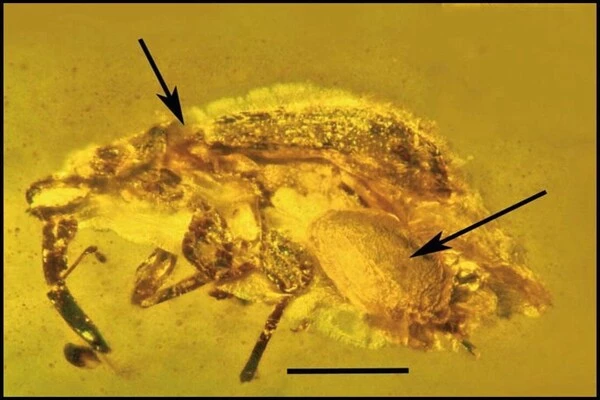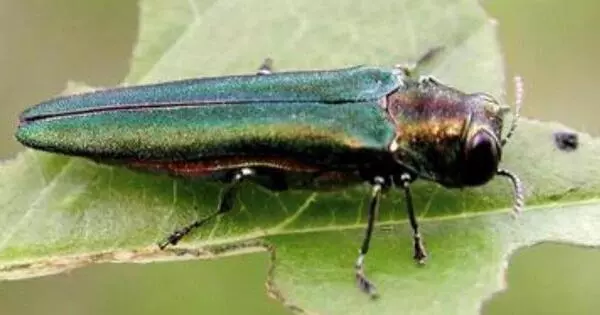Fossil research has revealed an exquisite marriage of art and science: a long-stemmed flower of a newly described plant species encased in a 30-million-year-old tomb alongside a parasitic wasp. A long-stemmed flower of a newly described plant species was discovered in a 30-million-year-old tomb alongside a parasitic wasp, according to Oregon State University fossil research.
“Everyone has their own way of interpreting visual images in the natural world based on interests, background, and current environment,” said George Poinar Jr. of the OSU College of Science. “As a result, an organism can be described, given a scientific name, and then classified in a taxonomic hierarchy. The same organism can be considered an art object and even assigned to a specific artistic period.”
According to a new study published in the journal Historical Biology, finding this insect and bloom suspended close together provides clues about their relationship in the tropical ancient ecosystem that they once inhabited. The bloom belonged to a previously unknown flower species in an extremely rare group, and inside one of its spherical seed pods was a secret stowaway: the developing larva of a minuscule fly, which may have been intended as a future meal for the wasp’s young.
Poinar’s study, published in Historical Biology, is the first to describe a fossil flower of the Euphorbiaceae family in amber, in this case amber from the Dominican Republic, which has some of the world’s clearest fossilized tree resin.
Everyone has their own way of interpreting visual images in the natural world based on interests, background, and current environment. As a result, an organism can be described, given a scientific name, and then classified in a taxonomic hierarchy. The same organism can be considered an art object and even assigned to a specific artistic period.
George Poinar Jr.
Members of Euphorbiaceae, also known as the spurge family, grow worldwide, with 105 of its 300 genera, and 1,800 species, found in tropical regions of the Americas. “Fossil flowers of members of this family are quite rare,” Poinar said. “I could only find one previously known fossil, from sedimentary deposits in Tennessee.”
Members of this family include the rubber tree, the castor-oil plant, and the poinsettia. Many members have milky latex, and some species are useful as a source of oil or wax.
Plukenetia minima was named after Poinar, an international expert in using amber-preserved plant and animal life forms to learn about the biology and ecology of the distant past. It is the first record of the genus Plukenetia on the island of Hispaniola, which is home to Haiti and the Dominican Republic, as well as the first fossil record of the genus.

Poinar said the mature female flower is noteworthy for its small size but lengthy stalk, which at the tip has four distinct capsules.
Poinar described the wasp, Hambletonia dominicana, as a new species in a separate paper published in Biosis: Biological Systems in 2020. It’s an encyrtid, a type of wasp that attacks a wide variety of insects. The flower in the current study has already bloomed and contains four maturing seed pods or capsules. A developing fly larva can be found in one of the pods.
“Unrelated organisms become entombed together in amber by chance in many cases,” Poinar said. “However, I believe that in this case, the wasp was drawn to the flower, either for nectar or to lay an egg on the capsule containing the fly larva.”
The wasp egg would then hatch, enter the pod and devour the fly larva, Poinar said, enabling the wasp to survive in the ecological niche created by the vegetation and flower heads of Plukenetia.
“Both of the fossils can be associated with two 20th-century art movements that appeared in fine art, design and architecture,” Poinar said. “The ‘petite’ flower represents the Art Nouveau style that emphasizes elegant curves and long lines. The ‘dancing’ wasp represents the Art Deco style that stresses sharp angles and decorative shapes.”
The delicate bodies of small insects, as well as the structures of tiny plants and flowers, rarely fossilize, and most have been lost to time. The amber inhabitants in this case are rare examples of fossils that retained significant structural details from when they were alive, providing a unique glimpse of their tropical “microhabitat” from the distant past, Poinar wrote in the study.
“The degree of preservation in amber is so much more complete than in other fossils,” Poinar said. “The amber fossils are lifelike, making the characters easy to describe. It’s as if they’ve just stepped into the amber.”





